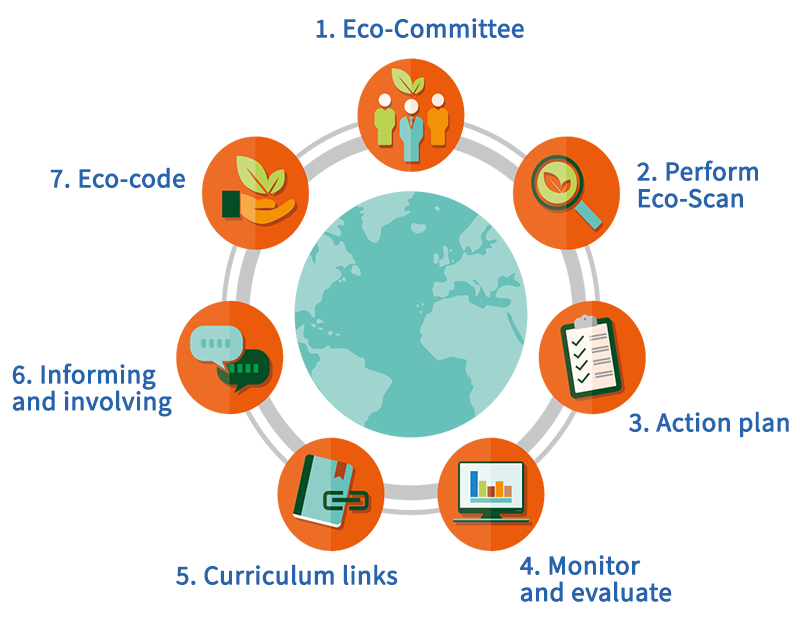All Eco-Schools worldwide work with the same Seven-Step Plan. The Seven-Step Plan supports the Eco-team to work systematically to achieve their goals. The figure below shows all the steps. Steps 2, 3 and 4 form a cycle of measuring, planning and evaluation that the Eco-team has to go through annually. Students analyze the situation at school and carry out actions to convert the education, building and the community in and around the school to a more sustainable environment. Gradually more and more people are getting involved. Furthermore, the Eco-code is the icing on the cake: the Eco-team can show in a creative what they would like to represent.
With the help of these seven steps, your school will give substance to the five pillars of Eco-Schools. In doing so, your school will work towards achieving the international hallmark for sustainable schools: the Green Flag. The crown on your work! Before that happens, you will also be eligible for two certificates. You will receive the Bronze certificate after completing steps 1 to 4. You will receive the Silver certificate after completing step 5.
Students are the driving force behind all steps. They investigate the school, think of actions and carry them out. Together with everyone in and around the school.

Stap 0. Declaration of Intent
Before we start with the Seven-Step Plan, there will be a festive kick-off by signing the declaration of intent. The declaration of intent can be signed with the signatures of the school director and the students from the Eco-team. Perhaps your parents and perhaps the councilor of the municipality will also sign? Anyone who has the intention to achieve the Green Flag together with the Eco-team can participate! Schools hang the declaration of intent in a central location and proudly show that they participate in Eco-Schools and are on their way to the Green Flag.
Step 1. Forming an Eco Committee
The Eco-Schools Committee is the driving force behind the Eco-Schools process and represents the ideas of the whole school.
Step 2. Environmental Review
This helps the school to identify its current environmental impact and highlights areas for improvement
Step 3. Action Plan
Results from the environmental review are used to design the Action Plan, forming the core of student action.
Step 4. Monitor & Evaluate
This is carried out find out if the targets set by the action plan are being achieved.
Step 5. Curriculum Work
Eco-Schools activities are linked to the curriculum, ensuring Eco-Schools is truly integrated within the school community.
Step 6. Informeren en betrekken
This involves getting everyone on board! Actions are not solely confined to the school community but are encouraged to engage community members and parents, for example.
Step 7. Eco Code
Students collaborate to devise a statement that represents the school's commitment to the environment.
Have you completed all seven steps? Then you have given your school a step-by-step implementation of the five pillars of Eco-Schools and your school deserves the Green Flag!
Read more about obtaining the Green Flag
After the first Green Flag
After step 7 and obtaining the Green Flag the process does not stop. In fact, for some schools it really starts! At some schools a small group of enthusiasts can quickly get things done. At other schools it is less easy. Eco-Schools wants to support every school and every Eco-team on its own ambition and level, in order to grow together. In order to retain the Green Flag, the school continues to develop and is re-audited every two years. Most schools gradually grow to the next level of ambition.


